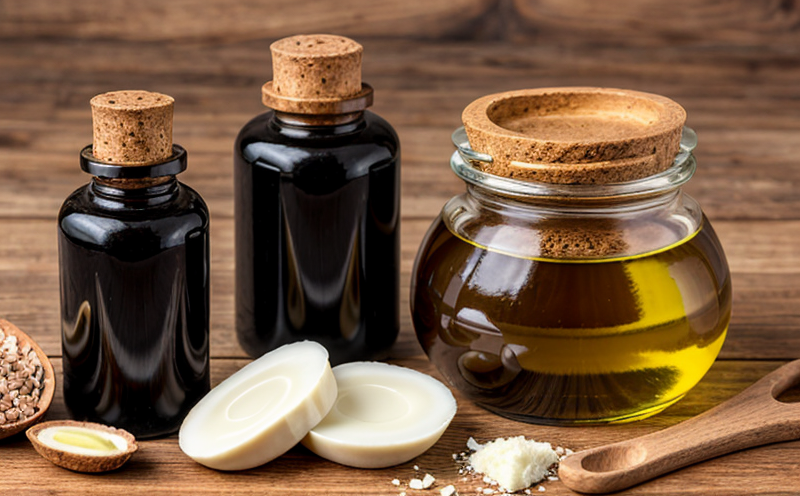ASTM E1871 Moisture Determination in Oils
The ASTM E1871 standard specifies a method for determining the moisture content in oils and fats using the Karl Fischer titration technique. This method is particularly useful for quality control and compliance purposes, especially in sectors like food, pharmaceuticals, and feed industries where moisture levels can significantly impact product quality and safety.
The ASTM E1871 standard ensures that moisture content is accurately measured to meet regulatory requirements and internal standards. The test is critical for monitoring the integrity of oil products during processing and storage. Moisture contamination in oils can lead to degradation, increased oxidation rates, and reduced shelf life, all of which are detrimental to the quality and safety of food and feed products.
The Karl Fischer titration method measures moisture by reacting it with sulfur dioxide (SO₂) and iodine (I₂). The reaction consumes water molecules, leading to a color change in the solution. This color change is detected by an electrode, which stops when all available water has been consumed, providing an accurate measurement of moisture content.
The accuracy and reliability of ASTM E1871 depend on several factors including sample preparation, reagent purity, and operator skill. Proper sample preparation ensures that the sample is representative of the product being tested. This includes ensuring that the sample is homogenous and free from contaminants that could interfere with the titration process.
Understanding the ASTM E1871 method helps in identifying potential issues in oil production processes. For instance, high moisture levels might indicate improper drying or storage conditions. Conversely, low moisture content can suggest excessive processing temperatures or vacuum drying times. By regularly monitoring moisture content using this standard, quality managers and compliance officers can ensure that their products meet the highest standards of safety and quality.
The ASTM E1871 method is widely recognized for its precision and reliability in measuring trace amounts of water in oils and fats. Its use in industries such as food and feed manufacturing ensures that consumers are provided with safe, high-quality products. Compliance officers can rely on this method to ensure their products meet regulatory requirements and internal quality standards.
Scope and Methodology
| Sample Type | Oils and fats |
|---|---|
| Method Used | Karl Fischer titration |
| Reagents Required | Sulfur dioxide, iodine, methanol |
The ASTM E1871 method involves the use of Karl Fischer titration to determine moisture content in oils and fats. The process begins with the preparation of a standard solution containing known amounts of water, sulfur dioxide, iodine, and methanol. This solution is used to calibrate the instrument.
Once calibration is complete, the sample is weighed into a reaction vessel. A reagent blank (a reagent without water) is also prepared for reference. The titration process then begins by adding the reagent to the sample in small increments. An electrode detects changes in conductivity as water reacts with sulfur dioxide and iodine.
The titration continues until all available water has been consumed, indicated by a sudden change in conductivity that triggers the end point of the reaction. The volume of reagent used is then calculated, which allows for the determination of moisture content based on the known concentration of the reagent blank.
Quality and Reliability Assurance
The ASTM E1871 method ensures high-quality results through rigorous quality control measures. Regular calibration of instruments with certified reference materials is essential to maintain accuracy. Laboratories should also participate in proficiency testing programs to ensure that their methods are consistent with industry standards.
Training and certification of personnel involved in the titration process further enhance reliability. This includes understanding proper sample preparation techniques, recognizing common sources of error, and interpreting results accurately. Compliance officers play a crucial role in ensuring that all personnel adhere to these best practices.
In addition to laboratory procedures, quality assurance also involves regular audits and reviews of test protocols. These audits help identify areas for improvement and ensure that all processes are compliant with international standards such as ISO 17025 (conformity assessment laboratories).
The use of advanced analytical equipment like the Metrohm Karl Fischer Titrator further enhances reliability by providing precise, repeatable results. This equipment is capable of detecting moisture levels down to parts per million, ensuring that even trace amounts are accurately measured.
Environmental and Sustainability Contributions
The ASTM E1871 method contributes positively to environmental sustainability by promoting efficient resource use. By accurately measuring moisture content, industries can optimize processing conditions to minimize waste and energy consumption. For example, precise drying processes reduce the amount of water used in production.
Additionally, monitoring moisture levels helps prevent spoilage and contamination, reducing the need for reprocessing or disposal of spoiled products. This not only conserves resources but also minimizes environmental impact by avoiding unnecessary emissions associated with waste management.
In the food industry, accurate moisture measurement ensures that products meet quality standards without adding excess water. This reduces the carbon footprint of transportation and storage, as less space is needed for packaging. In the pharmaceutical sector, maintaining proper moisture levels in oils can extend product shelf life, reducing the amount of unsold stock sent to landfills.





